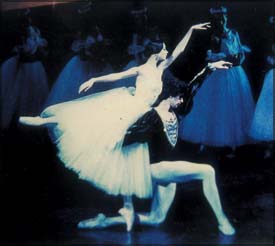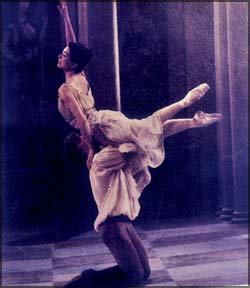|
The strength of ballet:
The birth of classical ballet
Gwen Herat
The strength of ballet is in its appeal that has been codified,
developed and refined down the years without any adulteration in the
process. The generation of dancers and choreographers set the standard
for others to follow within the framework of its syllabus in classical
ballet.
The dancers of the Renaissance Italy inspired and motivated the Court
of Louise XIV of France who later codified dance. That was the first
major step towards the establishment of the school of classical ballet.
 |
|
Svetlana Lankin and Nikolai
Tsaiskarvidez |
This paved the opportunity for a dancer to perform in Nigeria, fly to
Australia and teach a student and practice in New Zealand and join a
ballet company in the USA. She can repeat this process ten years later
and still retain the same technique as the syllabus demands. She will
never differ as much as a step or a leap. This is possible because
ballet has no dialogue and hold no difference to music wherever it is
performed. Six or ten nationals can dance together without uttering a
word without a single mistake in their steps.
Reflecting on the very substance of this art, we are amazed at the
technical grace which existed between Margot Fonteyn and Rudolf Nureyev
of the Royal Ballet. That they performed flawlessly the very syllabus
from which the steps were taken to evolve famous ballets we see around
the world.
People know very little how tirelessly and at time, erroneously the
steps were developed into a syllabus the students go through today to
become a ballerina and her partner who later dance in many classics,
fairy stories and plays from Shakespeare.
Ballet would be in absolute shambles of many difference techniques
gone haywire if not for the fact that a vocabulary of techniques, styles
and steps were established for the performance of classical ballet and
strictly adhered to.
Styles
Just as much there are different national styles of teachings from
France, England, Russia etc, they will follow the same process though
from the time the French were used to demonstrate various positions,
steps and movements of ballet, the instructions one will hear will be
the same. However, ballet language is in French and students get used to
them as they progress in their dancing.
When opera was considered respectable, ballet in the background was
stirring to be noticed but it was not considered good enough for girls
from high class. Not long after that, ballet with its sensual and
physical attraction ultimately became the most sought after and
respected performing art in the world.
Today ballet is held in high esteem as people go to see it for the
sake of its art and performing prowess rather than of sex-appeal or
physical entertainment.
The emotional and physical contact between partners, very often
stirred up artistic love and if I am to mention a good example is that
of Fonteyn-Nureyev partnership. While they were at the Royal Ballet, it
was assumed they would fall in love over and over again bringing depth
to their characters, especially in Romeo and Juliet.
Mental stimulation, athleticism, visual and emotional intensity,
bodily contact and anatomical charisma are some of the essences
portrayed by leading dancers at the peak of their careers.
Though the societies of those eras considered ballet a crude form,
the ancients of this art, held it sacred and its invention to Gods and
immortals. To some, dancing was an expression of religious fervour and
among the Greeks, a symbol of worship. It was during the Middle Ages
that the so called ballet made its way to the church.
The choirboys performed a style of dance before the altar on a number
of religious occasions in Seville. So, eventually there began the
experiment of new lines of expression with an effort for a spectacular
and refined presentation.
Complicated
Ballet had a very difficult and complicated birth but by the time the
Romantic Period arrived, it was ready for revisal. The make believe
world of swans, fairies, sylph and goblins emerged into dancing
characters which later were seen in classics like the Swan Lake ballet.
One by one, the steps and movements recorded into the syllabus.
Around 1789, Dauberval mounted two feature called La Fille and Gardee in
Bordeux and set the general plant for ballet which survives in the
repertoires of many famous dancing companies around the world,
especially in the Soviet.
This was after Louis XIV founded the LíAcademic Nationale de la Danse
in France in 1661. Thanks to his royal patronage. Ballet began to assume
a new age in respectability.
Smitten by the Romantic periodís progress of this fine art and what
followed thereafter, many distinguished dancers, composers and
choreographers found a niche in the annals of dance. The greatest of
them all was the Swiss-French choreographer, Jean-Georges Noverre
(1727-1810).
He ranked the greatest before the she emergence of Rudolf von Label,
Michael Fokine, (centuries apart and followed by Marius Petipa, Roland
Petit, Kenneth MacMillan, Vaslav Nijinsk Fredrick Ashton, Martha Graham
and Rudolf Nureyev (more generations apart).
 |
|
Rudolf
Nureyev and Margot Fonteyn |
Gradually, more techniques in both male and female dancers assumed
prominence which they enjoy today. However, the female principal dancer
being the attraction, always held centre-stage.
However good her partner was, he was delegated second place until the
early 1960s. When all this was happening, Rudolf Nureyev defected from
Russia in 1961 and conquered the West as he generated a new approach to
Ballet.
He stirred public interest with his explosive stage personality and
athletism that the audience of the day had eyes only for him. By this
act, he put the male dancer centre stage and created a spectacular
partnership that both enjoyed together.
As much as literature, art, music and drama sought an escape from the
shackles of tradition, ballet too freed itself from constrain to be what
it is today. It inspired and impressed intellects as well as composers
with a new fervour. They basked in its magical feel.
The great ballet composer, Peter Tohaikvosky scored the music for
Swan Lake after a personal experience he had that touched his heart with
excitement. He used to visit his sisterís house which was on the bank of
lake and watched her children play.
When they retired to bed, he also saw a number of swans descend..
upon the water by moonlight and frolic until the arrival of beautiful
swan around whom the lot used to dance till late.
Next, they would fly away into the night only to return again day
after day. In his mind, Tohaikosky made music with the sound of swirling
water the crash of wings and the smooth sail when the swans glided.
By the time he had the full score locked in his mind, he saw
something missing to turn this into a ballet. So, he placed Prince
Siegfried beside the lake and turned the swan into a princess. Thus the
Swan Lake was born in all its pathos and lost love. |



